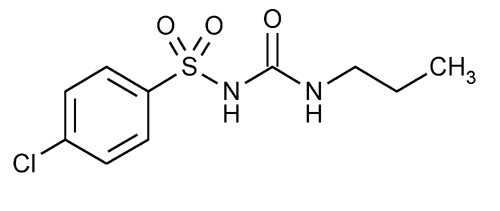Chlorpropamide
Benzenesulfonamide, 4-chloro-N-[(propylamino)carbonyl]-.
1-[(p-Chlorophenyl)sulfonyl]-3-propylurea
» Chlorpropamide contains not less than 97.0 percent and not more than 103.0 percent of C10H13ClN2O3S, calculated on the dried basis.
Packaging and storage—
Preserve in well-closed containers.
Identification—
B:
It responds to the Thin-Layer Chromatographic Identification Test  201
201 . Prepare the test solution by dissolving an accurately weighed quantity of Chlorpropamide in acetone to obtain a solution containing 1 mg per mL. Develop the chromatogram in a solvent system consisting of a mixture of methylene chloride, methanol, cyclohexane, and ammonium hydroxide (100:50:30:10).
. Prepare the test solution by dissolving an accurately weighed quantity of Chlorpropamide in acetone to obtain a solution containing 1 mg per mL. Develop the chromatogram in a solvent system consisting of a mixture of methylene chloride, methanol, cyclohexane, and ammonium hydroxide (100:50:30:10).
Loss on drying  731
731 —
Dry it in vacuum at 60
—
Dry it in vacuum at 60 for 2 hours: it loses not more than 1.0% of its weight.
for 2 hours: it loses not more than 1.0% of its weight.
Residue on ignition  281
281 :
not more than 0.4%.
:
not more than 0.4%.
Selenium  291
291 :
0.003%.
:
0.003%.
Heavy metals, Method II  231
231 :
0.003%.
:
0.003%.
Assay—
Mobile phase—
Prepare a filtered and degassed mixture of equal volumes of acetonitrile and dilute glacial acetic acid (1 in 100). [note—Do not exceed 50% of acetonitrile.] Make adjustments if necessary (see System Suitability under Chromatography  621
621 ).
).
Standard preparation—
Dissolve an accurately weighed quantity of USP Chlorpropamide RS in Mobile phase, and dilute quantitatively, and stepwise if necessary, with Mobile phase to obtain a solution having a known concentration of about 0.05 mg per mL.
Assay preparation—
Transfer about 50 mg of Chlorpropamide, accurately weighed, to a 100-mL volumetric flask, add Mobile phase to volume, and mix. Transfer 10 mL of this solution to a second 100-mL volumetric flask, add Mobile phase to volume, and mix.
Chromatographic system
(see Chromatography  621
621 )—The liquid chromatograph is equipped with a 240-nm detector and a 4.6-mm × 25-cm column that contains packing L1. The flow rate is about 1.5 mL per minute. Chromatograph the Standard preparation, and record the peak responses as directed under Procedure: the tailing factor for the analyte peak is not more than 1.5, and the relative standard deviation for replicate injections is not more than 2.0%.
)—The liquid chromatograph is equipped with a 240-nm detector and a 4.6-mm × 25-cm column that contains packing L1. The flow rate is about 1.5 mL per minute. Chromatograph the Standard preparation, and record the peak responses as directed under Procedure: the tailing factor for the analyte peak is not more than 1.5, and the relative standard deviation for replicate injections is not more than 2.0%.
Procedure—
Separately inject equal volumes (about 20 µL) of the Standard preparation and the Assay preparation into the chromatograph, record the chromatograms, and measure the responses for the major peaks. Calculate the quantity, in mg, of C10H13ClN2O3S in the portion of Chlorpropamide taken by the formula:
1000C(rU / rS)
in which C is the concentration, in mg per mL, of USP Chlorpropamide RS in the Standard preparation, and rU and rS are the peak responses obtained from the Assay preparation and the Standard preparation, respectively.
Auxiliary Information—
Please check for your question in the FAQs before contacting USP.
Chromatographic Column—
| Topic/Question | Contact | Expert Committee |
| Monograph | Elena Gonikberg, Ph.D.
Senior Scientist 1-301-816-8251 |
(MDGRE05) Monograph Development-Gastrointestinal Renal and Endocrine |
| Reference Standards | Lili Wang, Technical Services Scientist 1-301-816-8129 RSTech@usp.org |
USP32–NF27 Page 1917
Chromatographic columns text is not derived from, and not part of, USP 32 or NF 27.
